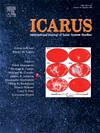Analysis on the source position of Zhinyu crater ejecta
IF 2.5
2区 物理与天体物理
Q2 ASTRONOMY & ASTROPHYSICS
引用次数: 0
Abstract
Impact craters are prevalent features on the Moon, and a significant volume of materials from the impact site is delivered to distant during their formation. The impact ejecta is closely related with many other surface processes, and some empirical equations inherent have been proposed in the studies. For example, a power-law relationship indicating a decrease in ejecta thickness with distance has been derived from dimensionless analysis, and it has been verified through laboratory experiments, numerical simulations, and remote sensing observations. A power-law relationship between launch speed and position of ejected materials is also suggested. However, no simple power-law exists for the initial and maximum excavation depths and the final position of ejecta. In this study, we used high-resolution numerical simulations of Zhinyu crater to explore the relationship between excavation depth and ejecta distance. A model for maximum excavation depth, based on the Maxwell Z-model, was further presented and found consistent with numerical simulation results.
直峪火山口喷出物源位置分析
陨石坑是月球上普遍存在的特征,在它们形成的过程中,来自撞击地点的大量物质被运送到遥远的地方。碰撞抛射与许多其他表面过程密切相关,并在研究中提出了一些固有的经验方程。例如,从无量纲分析中得出了一个幂律关系,表明喷出物厚度随距离的减少,并通过实验室实验、数值模拟和遥感观测进行了验证。提出了弹射速度与弹射材料位置之间的幂律关系。但对于初始开挖深度、最大开挖深度和最终喷出物位置,不存在简单的幂律。本文采用高分辨率数值模拟方法,探讨了直峪陨石坑开挖深度与喷出物距离的关系。进一步建立了基于Maxwell z模型的最大开挖深度模型,与数值模拟结果一致。
本文章由计算机程序翻译,如有差异,请以英文原文为准。
求助全文
约1分钟内获得全文
求助全文
来源期刊

Icarus
地学天文-天文与天体物理
CiteScore
6.30
自引率
18.80%
发文量
356
审稿时长
2-4 weeks
期刊介绍:
Icarus is devoted to the publication of original contributions in the field of Solar System studies. Manuscripts reporting the results of new research - observational, experimental, or theoretical - concerning the astronomy, geology, meteorology, physics, chemistry, biology, and other scientific aspects of our Solar System or extrasolar systems are welcome. The journal generally does not publish papers devoted exclusively to the Sun, the Earth, celestial mechanics, meteoritics, or astrophysics. Icarus does not publish papers that provide "improved" versions of Bode''s law, or other numerical relations, without a sound physical basis. Icarus does not publish meeting announcements or general notices. Reviews, historical papers, and manuscripts describing spacecraft instrumentation may be considered, but only with prior approval of the editor. An entire issue of the journal is occasionally devoted to a single subject, usually arising from a conference on the same topic. The language of publication is English. American or British usage is accepted, but not a mixture of these.
 求助内容:
求助内容: 应助结果提醒方式:
应助结果提醒方式:


